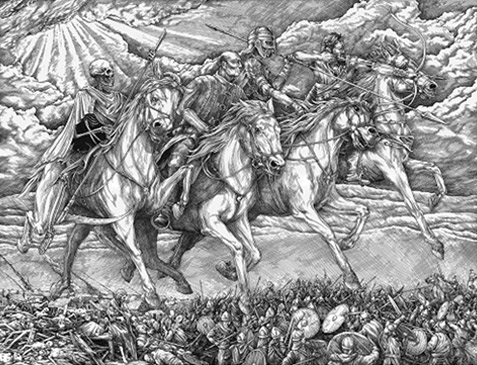
The Great War lasted for one thousand five hundred and sixty days, a total of four years and fourteen weeks. In all it is said to have claimed ten million military deaths. Eight million civilians died directly attributed to war events and a further six million in the immediate aftermath due to famine, disease, civil disorder and deprivation. It was probably the most traumatic event in Europe history since the Black Death of 1347 – 51 when a third of Europe’s population died.
– The Four Horsemen of the Apocalypse: War, Pestilence, Famine and Death
Albrecht Durer (1471-1528)
There were spontaneous celebrations throughout the United Kingdom when peace was announced on November 11 1918. In Wicklow town soldiers of the Royal Sussex Regiment took to the streets informally, the regimental band playing, and for a brief time locals and military fraternised in mutual accord as Union Jacks emblazoned the streets and the church bells rang out over the town. Even the normally diligent Royal Irish Constabulary turned a blind eye to pubs breaching the then strict opening hours. In Arklow, where the same public parading as in Bray and Wicklow took place, Messer’s Kynoch gave all workers a half day off and St Saviours bells pealed for twelve hours, as did the bells of all the Irish Church throughout the county where a bell ringer could be found. On Sunday 17 of November there were low key thanksgiving services and the many dead were remembered at Roman Catholic masses as the county as did the country slowly took stock from the catastrophe that had befallen their communities over the previous four years.
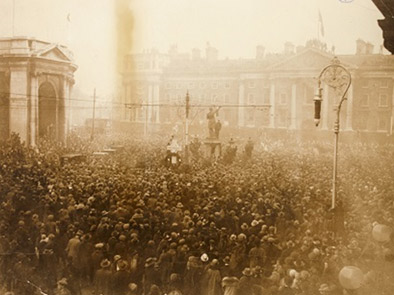
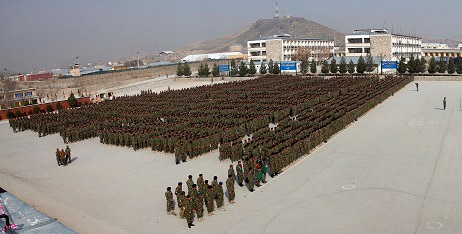
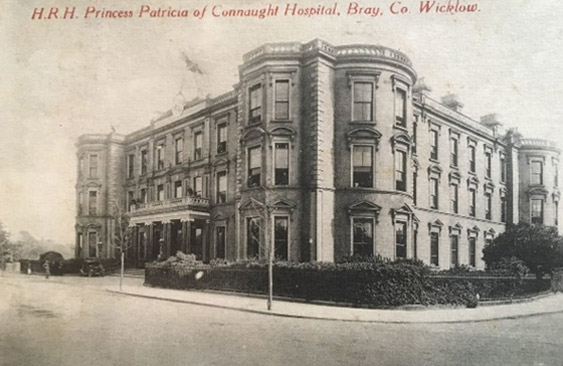
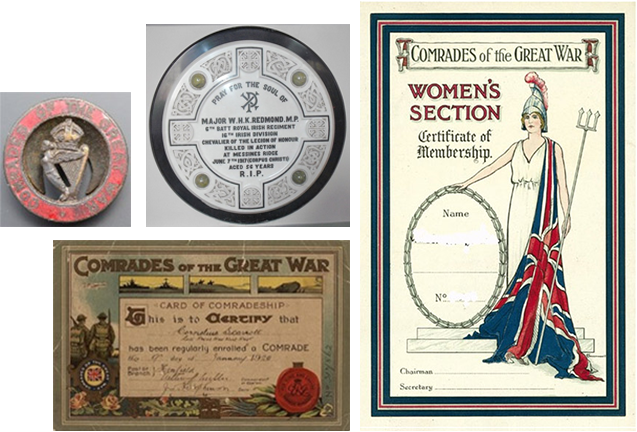
Many of those injured whom came home soon died of their wounds. A ratio of severely wounded to those killed was about 2.8 which would represent an actual figure of 3600 shattered injured persons back in the county. These were generally persons who would depend on external help to have any kind of life quality. There were then many others deemed ‘lightly’ injured, but in fact were seriously compromised but managed to integrate back to the community on their own physical and mental resources. It is unknown how many were mentally shattered by their experiences. Post Traumatic Shock and all mental conditions in military service people were generally lumped into a catchall term called ‘Shell Shock’
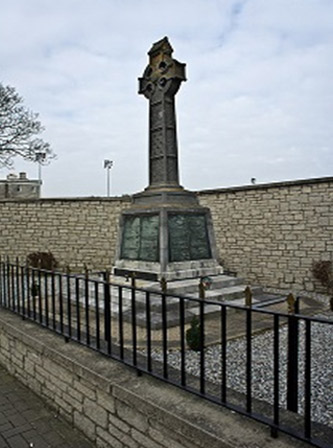
Over the next twenty turbulent years conflicting political events in Ireland overshadowed the legacy of the Great War. There was little unity in mode of remembrance. In the immediate post-war years local committees were formed and some memorials were commissioned In County Wicklow as the fine memorial in Bray. The Haigh Fund, later the Royal British Legion gave generous financial support to veterans and their families. As funds became available model housing schemes were erected in various towns and villages in the county. Most of these schemes still stand and are generally known as ‘soldier’s houses’. Unfortunately historic pre-war religious division heavily influenced commemoration in various churches. Few Roman Catholic churches gave outward manifestation to the dead of the Great War. There were exceptions such as Kilquade where the beautiful William Redmond plaque is to be seen.
Immediately after the war various groups and organisations were formed to further the welfare of the war veterans and their dependents and to commemorate the fallen. Remembrance Day became an annual feature in County Wicklow but was largely organised in the bigger urban areas of the principal towns of Bray, Wicklow and Arklow.
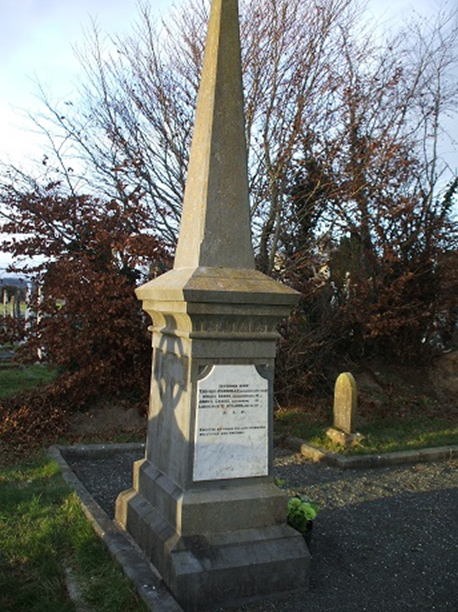
In the aftermath of the Irish War of Independence and the Civil War there were muted official commemorations for the dead of the Great War. An exception was the beautiful national memorial at Islandbridge in Dublin which did receive substantial government support even through the most adverse relations between the British and Irish governments. Annual commemorations of Remembrance Day and the public exposure of the poppy as the emblem of the war veterans was divisive and was hardly to be tolerated in some localised areas. There were reports of disturbances in Bray, Wicklow and Arklow by republicans and other elements hostile to any manifestations of past British military influences. Bray however, was still able to erect one of the first substantial Great War memorials in 1923 and was the venue for well supported annual remembrance parades for many decades.
Amid changing attitude, in Arklow a local committee struggled to raise funds for its memorial to the Kynoch munitions workers of that town who lost their lives in an explosion in 1917. In smaller towns and villages many veterans and their families felt it better not to commemorate publicly at all or else do it in private circumstances.
Throughout the 1930’s, as the participants of the Great War diminished, so too did public manifestation of its memory. In schools and college the history of the Great War was side-lined if mentioned at all. Almost all emphasis was placed on the national struggle and particularly the 1916 Rising. Within a generation of 1918, a national amnesia had set in that was not to be lifted until the Millennium.
The Woodenbridge County Wicklow World War One Memorial was not inaugurated until 2014, ninety nine years after the events.
The social history of the Second World War on Co. Wicklow and the names of those who gave their lives to defend the peace of Europe will be added at an appropriate time in the future.
In the conflict and over the four bloody years, through home volunteering, earlier emigration and conscription in the mainland United Kingdom, Wicklow born natives and other residents would find themselves serving in the numerous branches of the vast military organisations. The following 104 regiments and services listed are represented by names entered on the Wicklow County War Memorial:-
- Argyll and Southern Highlanders
- Australian Army Medical Corps
- Australian Engineering Corps
- Australian Infantry 4th Batt
- Australian Infantry 7th Batt
- Australian Infantry 25th Batt
- Australian Infantry 49th Batt
- Australian Infantry Unit 2
- Cameron Highlanders Regiment
- Canadian Infantry Alberta
- Canadian Infantry British Columbia
- Canadian Infantry Manitoba
- Canadian Infantry Quebec Division
- Canadian Infantry Saskatchewan
- Canadian Militia
- Canadian Mounted Rifles
- Ceylon Planters Rifle Corps
- Cheshire Regiment
- City of London Regiment
- Coldstream Guards
- Connaught Rangers
- Devonshire Regiment
- Duke of Cornwall Infantry
- Duke of Wellington’s Regiment
- Durham Light Infantry
- East Kent Regiment
- East Lancashire Regiment
- East Yorkshire Regiment
- Essex Regiment
- General List Dental Surgeon
- Ghurkha Rifles
- Gloucestershire Regiment
- Gordon Highlanders
- Grenadier Guards
- Hampshire Regiment
- Highland Light Infantry
- Highlanders Regiment
- Household Cavalry
- Indian Army Regiment
- Irish Guards
- Kings Own Regiment
- Kings Own Liverpool Regiment
- Kings Own Scottish Borderers
- Kings Own Yorkshire Light Infantry
- Kings Royal Rifle Corps
- Kynoch Munitions Factory Arklow
- Labour Corps
- Leinster Regiment
- London Regiment
- Machine Gun Corps
- Manchester regiment
- Merchant Marine
- Middlesex Regiment
- Military Police Corps
- New Zealand Brigade
- New Zealand Field Artillery
- New Zealand Rifle Brigade
- New Zealand Rifles 4th Batt
- New Zealand Training Unit
- New Zealand Wellington Regiment
- Northamptonshire Regiment
- Northamptonshire Fusiliers
- Northumberland Fusiliers
- North Irish Horse
- North Lancashire Regiment
- Queen Marys Army Auxiliary Corps
- Queens Own Cameron Rangers
- Queens Own Hussars
- Rifle Brigade
- Royal Air Force
- Royal Army Medical Corps
- Royal Army Ordinance Corps
- Royal Army Service Corps
- Royal Berkshire Regiment
- Royal Engineers
- Royal Engineers Pioneer Corps
- Royal Field Artillery
- Royal Flying Corps
- Royal Garrison Artillery
- Royal Highlanders (The Black Watch)
- Royal Dublin Fusiliers
- Royal Horse Artillery
- Royal Indian Marines
- Royal Inniskilling Fusiliers
- Royal Irish Fusiliers
- Royal Irish Rifles
- Royal Irish Regiment
- Royal Munster Regiment
- Royal Navy
- Royal Naval Reserve
- Royal Scots Regiment
- Royal Welch Regiment
- Royal West Surrey Regiment
- Shropshire Light Infantry
- Scots Guards
- South Africa Army Cape Force
- South Africa Infantry
- South Africa Infantry 2nd Regiment
- South Irish Horse
- South Lancashire Regiment
- Suffolk Regiment
- East Indian Regiment
- Wicklow Coastguard Station
- Worcestershire Regiment
